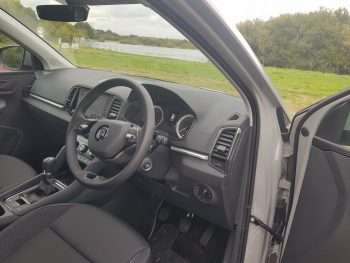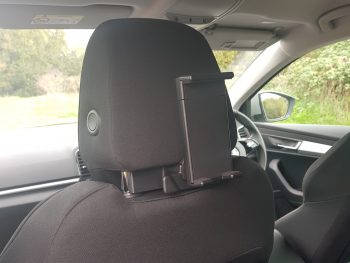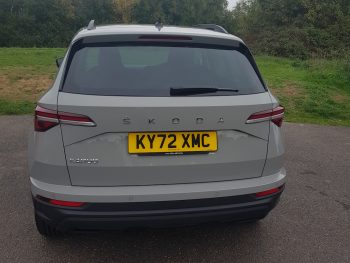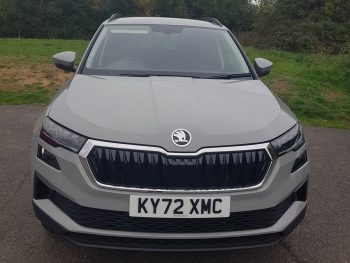Fleet World Fleet: Škoda Karoq
The Škoda Karoq continues to hold its own in the midsize SUV sector, including when it comes to looks.
Model: Karoq SE Drive 1.0 TSI 110PS
List price (BiK): £27,090 (31%) CO2: 133g/km MPG: 48.7mpg Test efficiency: 40.3mpg

The Skoda’s interior is lifted by various design flourishes
Report 4:
As is always the way when you switch to a new car, I’ve started to pay more attention to Karoqs out and about – as well as to rivals such as the Qashqai.
It’s led to some ruminations among friends and family as to which looks best and there’s quite a few in favour of the Škoda – that’s despite its overall unassuming and understated demeanour. A subtle facelift a year ago, which also introduced digital dash controls as standard, has further helped its case.
Our Meteor Grey metallic paint looks good and is on trend with the UK’s penchant for gunmetal shades – recent SMMT data for 2022 showed that grey was the UK’s favourite new car colour for the fifth year in a row.
A long work call while parked up in our midsize SUV recently also gave me another opportunity to appreciate the interior. It’s not the flashiest but there’s quite a few flourishes that lift the general ambience, including round the dials – and the top-rung SportLine puts far more of a focus on racy detailing. All in all, it was a pleasant place to while away an hour or so, aided also by the very comfy and supportive driver’s seat.
It also feels sturdy and robust in general, well-built and up to the demands of everyday family life.
I was already used to the infotainment system from the Fabia. A few buttons have switched over sides, but I’ve adjusted quick and found it really easy to use. The inclusion of physical controls for areas such as air con also make it easy to master.
The over-riding impression, as with our former Fabia long-termer, is that the Karoq is nothing but helpful, as demonstrated by its ‘Goodbye. Got everything? Everyone out the car?’ message as you disembark. Able to deal with the minutiae of everyday life and ready to assist.

We’ve found some features handier than others
Report 3:
The Karoq continued to perform well over a rather frenetic festive season, when its onboard space, frugality and comfort on long journeys proved most helpful; both for transporting family and presents pre-Christmas and for tip trips and general clear-outs after.
We’ve been regularly making use of its 1,630-litre of space in the boot – which is one of the biggest in its class. It was also handy to find the flippers in the boot for individually plopping down either side of the 60/40 split seats, making a recent trip to the ‘household waste recycling centre’ easier.
I’m yet to use the flip-down section through to the rear seats though or the 12V socket, sliding bag hooks, boot space dividers and storage net but they all add up to the overall family focus and hands-on appeal of the car. An adjustable boot floor would be handy though.
I’m starting also to think though that the Varioflex seats would be worth having. These do all sorts of whizzy things, such as sliding and reclining independently or folding forwards. While the rear seats deliver plenty of leg room, the ability to give passengers more room would have come in handy during a lengthy two-hour jam on the M27 recently when a relative was left dealing with two fractious kids in the rear. They cost an extra £745 (incl VAT) – which is worth the money to my mind – or come as standard on the SE L, which is the next trim up and costs from £27,485 (an extra £1,826).
I’ve also been lamenting the fact that Karoqs don’t come with the removable torch in the boot since the facelift – although the ice scraper has proved handy.
I’m really not a fan now though of the inbuilt phone holders on the back of the front seat headrests. The kids aren’t using them – easier to hold phones in their hands, especially when playing games – and I’ve lost track of the number of times I’ve hit my face/head on them while retrieving school bags, water bottles, coats etc in the dark.
Despite the shift to a larger car from our former Fabia, the Karoq remains nicely compact to drive and park, helped by a decent driving position and visibility. It’s particularly beneficial given my predominant suburban usage. Fuel economy is currently around 37mpg long term; not bad at all given its average 27mph speed in said suburban conditions.

Despite its compact footprint, space onboard the Karoq is great
Report 2:
The Karoq is fairly understated with what it does, but right from the start, it’s impressed us.
The afternoon it arrived was akin to a visit to Father Christmas’s grotto, with the kids and me exclaiming over what we found. They were most excited about the sheer size of the interior, the foldable tables and phone holders in the rear and the refinement. Me, I was genuinely delighted with the door pocket bin – after having spent a couple of hours cleaning our previous Fabia test car and being gobsmacked at the places where sweet wrappers can hide, it felt like a game changer.
Despite its compact footprint, space onboard the Karoq is great. My fast-growing teenage son has no problem for head or leg room, front or rear. Boot space is also extensive, starting at 521 litres and rising to 1,630. The Karoq can also be specified with the Varioflex option. Also available as standard on mid- and top-spec models, it upgrades the rear to three separate seats that can be adjusted horizontally and vertically, folded down or taken out of the car. Boot space for Varioflex-equipped models start from 588 litres, through to a spectacular 1,810.
Onboard storage is also extensive. It’s coping well so far with our array of everyday paraphernalia such as gym bottles and school essentials.
The Karoq also comes with the usual Škoda Simply Clever features, from the aforementioned rear tables and phone holders, to the appropriately called ‘Jumbo Box’ in the front featuring reversible cup holders, room for gadgets and house keys. It’s certainly made return journeys from the McDonald’s Drive Thru much easier.
I did struggle for a while finding the usual – and always handy – Simply Clever umbrella – normally hidden in the driver’s door and now tucked under the front passenger seat. But given the recent deluges, it’s made up for lost time fast.
The Karoq is also proving refined and comfortable behind the wheel, particularly for long journeys. More anon.

Our new long-termer Karoq
Report 1:
We’ve stayed within the Škoda family for our replacement to the Fabia, but switched to the Karoq midsize SUV.
First launched in 2017 as the replacement to the popular Yeti, it’s built on the MQB platform used for a diverse range of Volkswagen Group models, including the SEAT Ateca and VW Tiguan sister models and the larger Škoda Kodiaq five-/seven-seater SUV. Rivals include the Nissan Qashqai, Ford Kuga and Peugeot 3008.
It’s not the first time we’ve tested the Karoq but it’s the first time I’ve beaten colleagues to get behind the wheel and we’re now driving the facelifted version. Launched this year, it introduces design changes, including frontal styling that ties it in more with the Kodiaq, along with new tech such as full-LED Matrix headlights and an expanded range of assistance systems.
The engine range is broad and includes, dependent on trim, two petrols: an entry-level 110hp 1.0-litre petrol or a 150hp 1.5 TSI with an optional DSG automatic gearbox. Diesels climb from a 116hp to a 150 or 190hp 2.0-litre TDI. The lowest-powered diesel has the option of the DSG and the other two can be specified with both DSG and all-wheel drive. But there’s currently no mild hybrid or hybrid options, unlike rivals.
Ours is the small but by no means diminutive 110hp 1.0-litre, a step up from the 95hp unit in our former Fabia and with official figures of 133g/km CO2 combined – putting it in the 31% BiK bracket for 2022/23 and with combined fuel consumption of 48.7mpg.
Trim levels span the brand’s familiar SE Drive, SE L and SportLine designations. We’re in the SE Drive, which despite being the entry-level comes with an incredibly long catalogue of goodies to rival my youngest son’s wish list to Father Christmas. Highlights include 17-inch alloys, a leather multifunction steering wheel, 8-inch infotainment touchscreen, cruise control and speed limiter, driver fatigue sensor and dual-zone climate control. To name but a few.
Such is the list of standard kit that there are just two optional extras on ours: Meteor Grey metallic paintwork (£660) and the temporary steel space saver spare wheel (£170 – and worth every penny to my mind). Only thing it’s missing from my perspective is front parking sensors, available on the next trim up and which would be on my wish list to Santa.
It’s a car I’ve been eager to test and early impressions are that it’s smart-looking, functional, comfortable and with the same quiet finesse as the Fabia. All the better for handling six months of work and family life.












